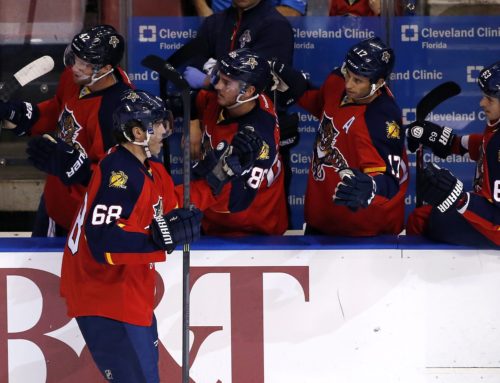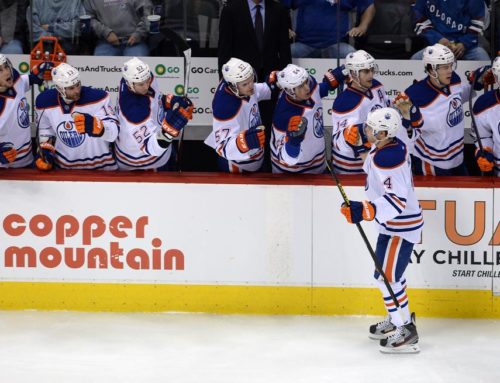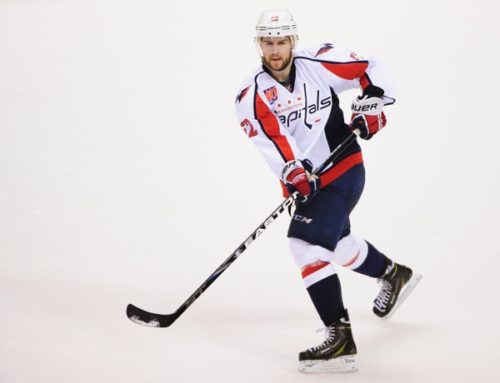The Ever-Challenging Goalie Market
steve laidlaw
2014-09-13

Factors to consider when drafting goalies in your fantasy league…
Henrik Lundqvist and Tuukka Rask may be the safest picks in nets, but Brian Elliott and Cory Schneider could be great value picks, and Thomas Greiss might be one of the most interesting hit-or-miss late-round gambles. What other secrets can hockey analytics help uncover?
There’s a lot more to goaltending analysis than save percentage. Recent developments in hockey analytics can help identify which goalies play in the toughest situations, how well they handle the dangerous shots, and who might be in the biggest fights for playing time.
Cam Ward, for example, is not likely to remain Carolina’s starting goalie. The following chart shows the combined 3-year even-strength save percentage for the top two goalies on all the NHL teams, with Anton Khudobin inserted as the Canes starter instead. He and the other number one goalies are on the vertical axis, with Ward and the backups on the horizontal axis.

Most teams are located right in the middle, with a starting goalie who is slightly better than the backup. That’s the standard situation that we all know and understand.
Some teams, like Colorado and Chicago, don’t have a proven backup. Without someone pushing for his job, that means that goalies like Semyon Varlamov and Corey Crawford could be better fantasy options than comparable goalies with more promising backups behind them, like San Jose’s Antti Niemi, Ottawa’s Craig Anderson, and Vancouver’s Ryan Miller.
The same can be said for teams where the starter has an apparently significant advantage over his backup, like Brian Elliott in St. Louis, Jimmy Howard in Detroit, Kari Lehtonen in Dallas, Cory Schneider in New Jersey, and Sergei Bobrovsky in Columbus, to name just a few. Tuukka Rask of the Bruins, Henrik Lundqvist of the Rangers, Jaroslav Halak of the Islanders, and Jonathan Quick of the Kings are all superior goalies, but have capable backups that might get an opportunity to take over if they were to struggle, or get hurt. That might cost them a few starts.
On the flip side, some teams have a backup goalie who is just as good as the starter, and arguably better. It’s therefore more of a risk to draft Pittsburgh’s Marc-Andre Fleury, for instance. He’d be a much safer pick if he was in the same situation as Philadelphia’s Steve Mason or Winnipeg’s Ondrej Pavelec, who are equally unspectacular, but are without similarly serious competition for the top job.
At first glance, it might therefore make sense to grab Fleury’s backup, Thomas Greiss, in a late round, but drafting a backup can be even more perilous than it would first appear. As Tom Awad revealed in Hockey Abstract 2014, backups start 56% of their games on the road, compared with just 46% for the starter. In an extreme case like Montreal, Carey Price started 37 of Montreal’s 41 home games, while Peter Budaj started 17 of his 21 games on the road! It was almost the same story in Colorado, too. That will take a huge bite out of any goalie’s stats.
And it gets worse. According to Awad’s study, backups get 58% of the pooped starts (as Jamie McLennan describes them), which is the second game in a back-to-back road trip. They also get 50% of those fatigued starts at home. That leads to tired defensemen and a lackluster offense for a large portion of their games played.
The takeaway lesson here is how important it is to consider the difficulty of a goalie’s assignment, which can be influenced by a wide variety of factors. Some goalies take on the top shooting opponents, like Pittsburgh and Chicago for example, while others more regularly face teams like Florida, where the shots are a little more harmless. Furthermore, some goalies play behind teams like Boston or Minnesota, where they’re given ample opportunity to see the shots coming, and less frequently need to handle rebounds or one-timers. Others, like those playing for Islanders, aren’t going to be as fortunate.
Consider the following goalie usage chart, where each of these factors over the past three seasons combined have been graphically portrayed. For each goalie, the average distance of the shots they’ve faced is on the horizontal axis, the average shooting percentage of the opponents they have faced is on the vertical axis, and the shaded circle represents how well they’ve performed relative to league average. Shaded is good, and the size of the circle represents the distance from league average.

This chart certainly puts the play of certain goalies in a new light. Those positioned in the bottom right, like Josh Harding and Tuukka Rask, are facing below-average opponents, and get plenty of time to see the shots coming (barring the effects of scorekeeper bias/error). Their stats could be reliant on those favorable conditions continuing throughout the season. Those more in the top left, like Justin Peters, Evgeni Nabokov, and the mighty Henrik Lundqvist, generally face tougher shots that are taken by better shooters.
Of course, just because a goalie has a tougher job doesn’t mean that he should be avoided. Some goalies actually thrive in the more difficult playing conditions. That’s the exact reason why we introduced home plate save percentage in this year’s Hockey Abstract.
Home plate save percentage measures how well goalies perform in shots taken exclusively in that dangerous area right in front of the net. This final chart includes the combined three-year home plate save percentage for every goalie in the league on the vertical axis, compared to how they perform on all the other shots on the horizontal axis. As you can see, not all goalies are created equally.

Based on this chart, you might allow your opponents to draft Henrik Lundqvist and Tuukka Rask early, as great as they may be, in the hopes of grabbing a potential bargain like Jaroslav Halak, Brian Elliott, or Cory Schneider in a later round. As for goalies like Ben Bishop, Josh Harding, and Carey Price, maybe leave them for someone else to gamble with.
There are a lot of factors that can influence a goalie’s production, and hockey analytics have come a long way in measuring them. The quality of the team’s other options, the difficulty of the shots faced, and the shooting abilities of one’s opponents can all be used to help place a goalie’s numbers into context, and help anticipate what they will be in the future.
With that information in mind, either grab Lundqvist and Rask early, or use those picks for a skater, and scoop up someone like Schneider or Elliott in a later round. And if you really want to add some unpredictability to your team this year, make Greiss one of your final selections.





 PHI
PHI WSH
WSH FLA
FLA MIN
MIN N.J
N.J T.B
T.B BUF
BUF DAL
DAL MTL
MTL NYR
NYR CBJ
CBJ TOR
TOR NYI
NYI DET
DET STL
STL WPG
WPG CHI
CHI VAN
VAN SEA
SEA COL
COL NSH
NSH BOS
BOS EDM
EDM CAR
CAR UTA
UTA OTT
OTT CGY
CGY PIT
PIT ANA
ANA S.J
S.J VGK
VGK L.A
L.A
